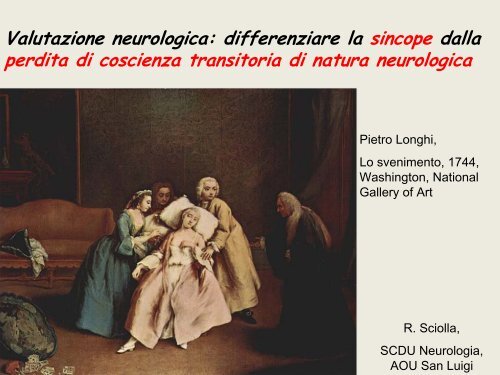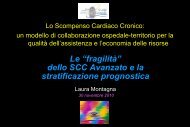Valutazione neurologica: differenziare la sincope dalla perdita di ...
Valutazione neurologica: differenziare la sincope dalla perdita di ...
Valutazione neurologica: differenziare la sincope dalla perdita di ...
You also want an ePaper? Increase the reach of your titles
YUMPU automatically turns print PDFs into web optimized ePapers that Google loves.
<strong>Valutazione</strong> <strong>neurologica</strong>: <strong><strong>di</strong>fferenziare</strong> <strong>la</strong> <strong>sincope</strong> dal<strong>la</strong><br />
<strong>per<strong>di</strong>ta</strong> <strong>di</strong> coscienza transitoria <strong>di</strong> natura <strong>neurologica</strong><br />
Pietro Longhi,<br />
Lo svenimento, 1744,<br />
Washington, National<br />
Gallery of Art<br />
R. Sciol<strong>la</strong>,<br />
SCDU Neurologia,<br />
AOU San Luigi
Sincopi e Neurologia<br />
Il Sig Rossi<br />
ha avuto una <strong>sincope</strong>:<br />
chiamiamo il Neurologo!<br />
NEUROLOGO<br />
?
ma talvolta rimangono dubbi: crisi epilettica /”pdc<br />
<strong>neurologica</strong>”/drop attack o <strong>sincope</strong> vera?..e talvolta una<br />
patologia <strong>neurologica</strong> è al<strong>la</strong> base <strong>di</strong> una <strong>sincope</strong> vera (es: ipotensione<br />
ortostat. in PK)
…senza<br />
<strong>di</strong>menticare il<br />
problema delle<br />
sincopi<br />
convulsivanti…
…definizioni e algoritmi possono facilitare il proce<strong>di</strong>mento<br />
logico:<br />
ESC, 2009
Per giungere ad una <strong>di</strong>agnosi:<br />
History is Key<br />
An Eyewitness<br />
Before/During and After the event<br />
The Clinical Background<br />
Dubbi sul<strong>la</strong><br />
<strong>di</strong>namica?
Ma è altrettanto vero che episo<strong>di</strong> non sincopali vengono<br />
talvolta <strong>di</strong>agnosticati come sincopi:<br />
??<br />
?
Teniamo però presente che, in genere, il<br />
ruolo del neurologo e degli accertamenti<br />
neurologici nelle TLOCS è limitato:<br />
Neurology and TLOCs<br />
Random EEG testing provides <strong>di</strong>agnostic<br />
information in
Retrospective study<br />
– 517 EEGs, between 2003-2007(falls, syncopes,<br />
convulsive syncopes)<br />
– 57 (11%) were “abnormal”<br />
• No clear epileptiform abnormalities<br />
Can J Neurol Sci 2009,36,769<br />
• 5 EEGs resulted in further investigations<br />
• 1 pt treated with PHT (despite Neurology’s advice!)<br />
yield was higher when ordered by ER physicians!
C<strong>la</strong>ssificazione “per<strong>di</strong>te per<strong>di</strong>te <strong>di</strong> coscienza<br />
neurologiche”: neurologiche : problema spinoso…<br />
spinoso
TLOCs neurologiche:<br />
(non dovute a cause esterne) Crisi epilettiche<br />
TIA (??)<br />
Cause rare (cisti colloide, Chiari I, ESA)<br />
TLOCs apparenti (no pdc!)<br />
neurologiche o psichiatriche:<br />
• Drop attacks<br />
• Pseudocrisi e pseudosincopi<br />
• Cataplessia e hyperekplexia
Crisi epilettiche<br />
Quali crisi?<br />
Se <strong>per<strong>di</strong>ta</strong> <strong>di</strong> coscienza: GENERALIZZATE:<br />
- toniche,<br />
- cloniche,<br />
- tonico-cloniche,<br />
- atoniche (rare)<br />
Però una crisi può essere SECONDARIAM<br />
generalizzata<br />
Meccanismo:<br />
Scariche <strong>di</strong> attività neuronale abnorme sincrona<br />
DIFFERENZE PRIMA, DURANTE E DOPO:
Syncope vs Seizure: Before Spell<br />
Trigger<br />
(position, emotion, Valsalva)<br />
American Epilepsy Society 2010<br />
Syncope Seizure<br />
Common Rare<br />
Sweating & nausea Common Rare<br />
Aura (e.g. déjà vu, smell)<br />
or uni<strong>la</strong>teral symptoms<br />
Hirsch et al, Merritt’s Textbook of Neurology, 2007<br />
Rare<br />
Commo<br />
n
Syncope vs Seizure: During Spell<br />
American Epilepsy Society 2010<br />
Syncope Seizure<br />
Pallor Common Rare<br />
Cyanosis Rare<br />
Loss of consciousness 60<br />
secs
Syncope vs Seizure: During Spell<br />
American Epilepsy Society 2010<br />
Syncope Seizure<br />
Automatisms Occasional Common<br />
Tongue biting, <strong>la</strong>teral Rare Occasional<br />
Frothing Rare Common<br />
Hirsch et al, Merritt’s Textbook of Neurology, 2007
Syncope vs Seizure: During Spell<br />
Movements<br />
American Epilepsy Society 2010<br />
Syncope Seizure<br />
Few clonic or<br />
myoclonic jerks<br />
or brief tonic<br />
posturing<br />
Mov. Duration < 15 seconds<br />
Hirsch et al, Merritt’s Textbook of Neurology, 2007<br />
Prolonged<br />
tonic phase »<br />
rhythmic<br />
clonic<br />
movements<br />
30 -120<br />
seconds
Syncope vs Seizure: After spell<br />
Confusion/<br />
<strong>di</strong>sorientation Rare;
Features That Are Not Helpful in<br />
Differentiating Syncope from Seizure<br />
Incontinence<br />
Dizziness<br />
Hirsch et al, Merritt’s Textbook of Neurology, 2007<br />
American Epilepsy Society 2010<br />
Injury other than<br />
<strong>la</strong>teral tongue biting<br />
Brief automatisms
539 pz con TLOC a patogenesi definita<br />
(437sincopi e 154 crisi epilettiche accertate)<br />
Questionario con 118 domande:<br />
le risposte più significativamente corre<strong>la</strong>te con<br />
l’una o l’altra <strong>di</strong>agnosi vengono selezionate per<br />
creare uno score <strong>di</strong>agnostico (espresso da un<br />
punteggio)<br />
Il punteggio derivato sul<strong>la</strong> base dei soli<br />
sintomi c<strong>la</strong>ssifica correttamente il 94% dei casi<br />
American Epilepsy Society 2010
Volete provare??
TLOCs neurologiche:<br />
(non dovute a cause esterne) Crisi epilettiche<br />
TIA (??)<br />
Cause rare (cisti colloide, Chiari I, ESA)<br />
TLOCs apparenti (no pdc!)<br />
neurologiche o psichiatriche:<br />
• Drop attacks<br />
• Pseudocrisi e pseudosincopi<br />
• Cataplessia e hyperekplexia
TIA????<br />
Definizione SPREAD (OMS): «improvvisa improvvisa comparsa <strong>di</strong> segni e/o<br />
sintomi riferibili a deficit focale cerebrale o visivo,<br />
attribuibile ad insufficiente apporto <strong>di</strong> sangue, <strong>di</strong> durata inferiore inferiore<br />
a<br />
24 ore.» ore.<br />
Non ci sono descrizioni atten<strong>di</strong>bili <strong>di</strong> TIA<br />
manifestatisi come iso<strong>la</strong>ta <strong>per<strong>di</strong>ta</strong> <strong>di</strong> coscienza<br />
Una sindrome da furto (es: del<strong>la</strong> succ<strong>la</strong>via) non è<br />
mai stata descritta determinare <strong>per<strong>di</strong>ta</strong> <strong>di</strong> coscienza<br />
in assenza <strong>di</strong> altri sintomi neurologici<br />
C: è corretto affermare che in linea <strong>di</strong> massima:<br />
un TIA è un deficit focale senza <strong>per<strong>di</strong>ta</strong> <strong>di</strong> coscienza<br />
una <strong>sincope</strong> è una <strong>per<strong>di</strong>ta</strong> <strong>di</strong> coscienza senza deficit<br />
focali
Non è un TIA:
TLOCs neurologiche:<br />
(non dovute a cause esterne) Crisi epilettiche<br />
TIA (??)<br />
Cause rare (cisti colloide, Chiari I, ESA,<br />
shunt malfunz., idrocefalo ostruttivo,<br />
trombosi massiva seni venosi)<br />
TLOCs apparenti (no pdc!)<br />
neurologiche o psichiatriche:<br />
• Drop attacks<br />
• Pseudocrisi e pseudosincopi<br />
• Cataplessia e hyperekplexia
Incremento repentino del<strong>la</strong> pressione intracranica<br />
Ostruzione improvvisa del deflusso liquorale<br />
+ CEFALEA!!!
TLOCs neurologiche:<br />
(non dovute a cause esterne) Crisi epilettiche<br />
TIA (??)<br />
Cause rare (cisti colloide, Chiari I, ESA,<br />
shunt malfunction, obstructive<br />
hydrocephalus, venous sinus occlusion)<br />
TLOCs apparenti (no pdc!)<br />
neurologiche o psichiatriche:<br />
• Drop attacks<br />
• Pseudocrisi e pseudosincopi<br />
• Cataplessia e hyperekplexia
…….IL .IL PZ PZ èè SEMPRE SEMPRE IN IN GRADO GRADO DI DI RICORDARE<br />
RICORDARE<br />
LE LE PERDITA PERDITA DI DI COSCIENZA?<br />
COSCIENZA?<br />
Circa il 30 % dei soggetti anziani cognitivamente<br />
intatti non sono in grado <strong>di</strong> ricordare cadute<br />
documentate dopo tre mesi<br />
Nel 50% dei casi non ci sono testimoni<br />
Nel 40% dei soggetti con sindrome del seno<br />
carotideo l’unico sintomo era <strong>la</strong> caduta o <strong>la</strong> caduta<br />
preceduta da “<strong>di</strong>zziness”<br />
Nel 20% dei casi <strong>di</strong> <strong>sincope</strong> durante MSC il paziente<br />
non ricorda <strong>di</strong> avere perso coscienza<br />
R.A Kenny. Kenny.<br />
The over<strong>la</strong>p between syncope and falls in the elderly” elderly<br />
Postgrad Med J 1997; 73: 635-9 635<br />
28
Drop attack: Improvvisa caduta a terra, in avanti,<br />
senza causa app., a coscienza conservata no amnesia<br />
E’ un Sintomo, non una <strong>di</strong>agnosi!<br />
E’ frequente negli anziani, specie donne, gen<br />
durante <strong>la</strong> marcia<br />
Meccanismi: proteiformi (sarcopatia, osteoartic) –<br />
spesso criptogenetici – ma con un sottogr. che<br />
risulta positivo al MSC e risponde a pacing!<br />
L’assenza <strong>di</strong> amnesia non esclude <strong>la</strong> <strong>per<strong>di</strong>ta</strong> <strong>di</strong><br />
coscienza (cfr: eventi testimoniati durante tilt tests<br />
negli anziani)
JAGS 53, 74-78, 2005<br />
93 pz >55aa con >3 d.a. ultimi 6 mesi:<br />
età me<strong>di</strong>a 77 aa, 70% femmine<br />
53% <strong>di</strong>agnosi car<strong>di</strong>ovasc: 40% del tot:<br />
ipersensibilità seno carotideo<br />
Permanent pacing in the treatment of CSH associated<br />
with recurrent falls: significant reduction in the<br />
number of events after permanent pacing (Kenny et al, JACC<br />
2001,38, 1491
Ma uno stu<strong>di</strong>o più recente…….
TLOCs neurologiche:<br />
(non dovute a cause esterne) Crisi epilettiche<br />
TIA (??)<br />
Cause rare (cisti colloide, Chiari I, ESA)<br />
TLOCs apparenti (no pdc!)<br />
neurologiche o psichiatriche:<br />
• Drop attacks<br />
• Pseudocrisi e pseudosincopi<br />
• Cataplessia e hyperekplexia
Psychogenic Non-epileptic Non epileptic Seizures<br />
10-45% of patients referred for intractable spells<br />
Females > males<br />
Psychiatric mechanism — <strong>di</strong>ssociation, conversion<br />
Common association with physical, emotional, or sexual abuse<br />
No obvious ictal eeg corre<strong>la</strong>tion : c<strong>la</strong>ssically normal awake<br />
background during episode of impaired consciousness<br />
Caveats: Diagnosis can be complicated<br />
The majority of simple partial seizures have no interictal<br />
EEG corre<strong>la</strong>tion<br />
Frontal lobe seizures may have unusual semiology and no<br />
<strong>di</strong>scernable EEG corre<strong>la</strong>tion<br />
American Epilepsy Society 2010
Psychogenic Non-epileptic Non epileptic Seizures<br />
FEATURES SUGGESTIVE OF NONEPILEPTIC PSYCHOGENIC<br />
SEIZURES<br />
Eye Closure<br />
Pelvic thrusting /Opisthotonus<br />
Side-to-side head shaking<br />
Prolonged duration (>4 minutes)<br />
Stopping and starting<br />
Suggestibility<br />
American Epilepsy Society 2010
Psychogenic Non-epileptic Non epileptic Seizures<br />
Features suggestive of Nonepileptic<br />
seizures<br />
Thrashing, struggling, crying, pelvic<br />
thrusting, side-to-side rolling, wild<br />
movements<br />
Preserved consciousness with bi<strong>la</strong>teral<br />
tonic or clonic mts<br />
American Epilepsy Society 2010<br />
Important Caveats<br />
Bizarre complex automatisms can<br />
occur with frontal lobe seizures<br />
Frontal lobe seizures may have<br />
bi<strong>la</strong>teral convulsive movements<br />
without impairment of consciousness<br />
Lack of postictal confusion Posti-ictal confusion is often absent<br />
after frontal lobe seizures<br />
Postictal crying or shouting Aggressive and emotional behavior<br />
can occur after epileptic seizures
Psychogenic Non-epileptic Non epileptic Seizures<br />
Once recognized, approximately 50%<br />
respond well to specific psychiatric<br />
treatment<br />
Epileptic and nonepileptic seizures may<br />
co-exist<br />
Video-EEG monitoring often required for<br />
<strong>di</strong>agnosis<br />
American Epilepsy Society 2010
American Epilepsy Society 2010
TLOCs neurologiche:<br />
(non dovute a cause esterne) Crisi epilettiche<br />
TIA (??)<br />
Cause rare (cisti colloide, Chiari I, ESA)<br />
TLOCs apparenti (no pdc!)<br />
neurologiche o psichiatriche:<br />
• Drop attacks<br />
• Pseudocrisi e pseudosincopi<br />
• Cataplessia e hyperekplexia
Cataplessia: associa ad altri sintomi <strong>di</strong> Narcolessia<br />
Cataplessia: associa ad altri sintomi <strong>di</strong> Narcolessia<br />
Tetrade narcolettica:<br />
Narcolessia: bisogno irresistibile <strong>di</strong> dormire, eccessiva<br />
sonnolenza <strong>di</strong>urna<br />
Cataplessia: improvvisa <strong>per<strong>di</strong>ta</strong> del tono musco<strong>la</strong>re<br />
dopo stimolo emotivo (riso, ira), riproducibile con<br />
idoneo stimolo, a coscienza conservata – anche se il pz<br />
può essere impossibilitato a par<strong>la</strong>re, rimane<br />
consapevole dell’ambiente (no amnesia, ma possibile<br />
confusione se concomitante attacco <strong>di</strong> sonno). Più<br />
frequentem: eventi parziali: improvvisa caduta del<strong>la</strong><br />
man<strong>di</strong>bo<strong>la</strong> o del capo<br />
Paralisi ipnagogica, allucinazioni ipnagogiche (gen: in<br />
fase <strong>di</strong> addormentamento)<br />
Tutte corre<strong>la</strong>te al sonno REM; substrato: deficit<br />
ipocretina ipota<strong>la</strong>mica, possib mecc autoimmune<br />
(associaz HLA-DQ)
Hyperekplexia (“startle ( startle syndrome”)<br />
syndrome<br />
Hyperekplexia is primarily an autosomal<br />
dominant <strong>di</strong>sease characterized by<br />
exaggerated startle reflex<br />
Different mutations in the alpha1 subunit<br />
of inhibitory glycine receptor (GLRA1)<br />
gene have been identified in many<br />
affected families.<br />
It can be associated with sudden infant<br />
death from apnea or aspiration pneumonia<br />
and serious injuries and loss of<br />
ambu<strong>la</strong>tion from frequent falls
Grazie per l’attenzione!




